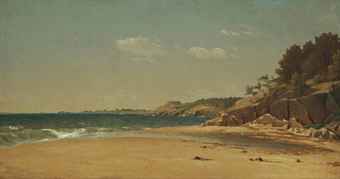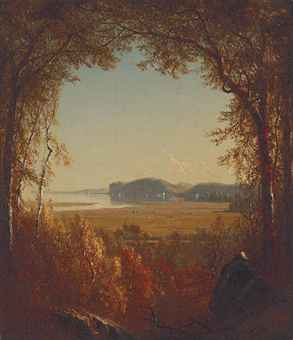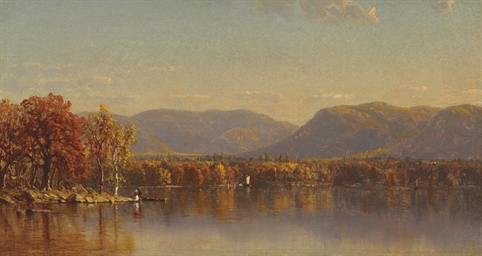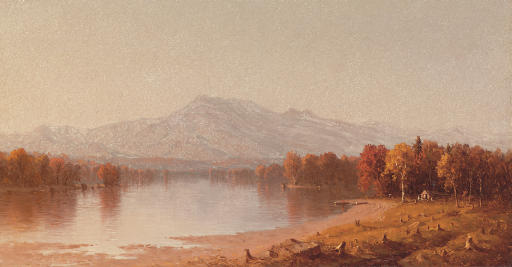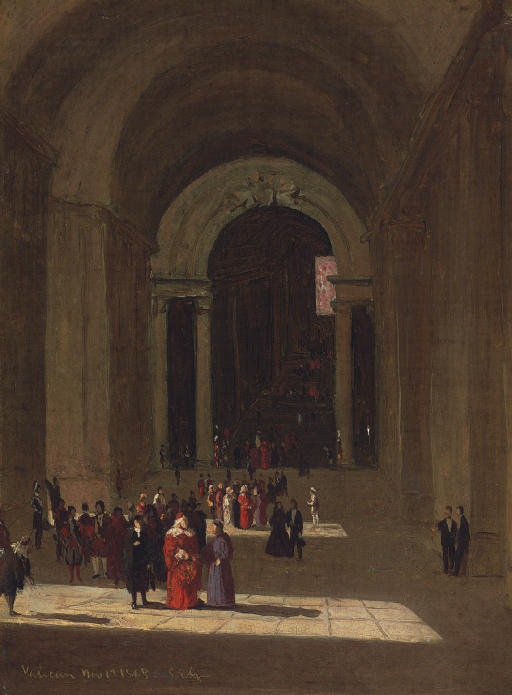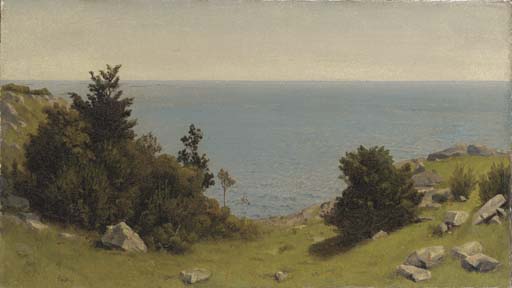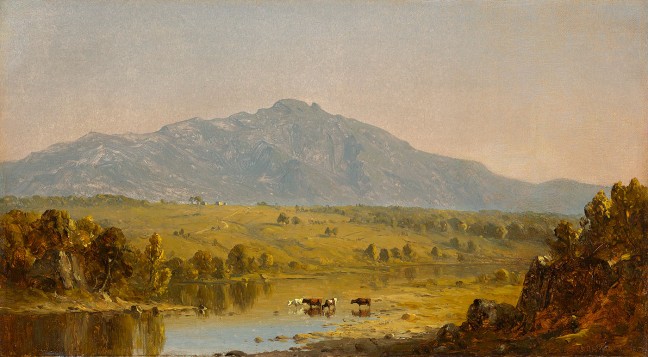Biography - Questroyal Fine Art, LLC, New York, New York
By Amy Spencer
The
second-generation Hudson River School painter Sanford Robinson Gifford was a
master at depicting light and atmosphere in landscapes. As the only painter
among his contemporaries to be born and grow up in the heart of the Hudson
River Valley, Gifford had a special affinity for the mountains, valleys, and
rivers of the region. Over the course of his career he also traveled
extensively around the Catskill, Adirondack, and White Mountains, and ventured
abroad on painting trips throughout Europe and the Middle East. This
contrasting subject matter demonstrated his skill at depicting various ambient
atmospheres with sincerity, charm, and realism.
Sanford
Robinson Gifford was born in Greenfield, New York. He spent his childhood in
Hudson (on the Hudson River south of Albany) where his father operated iron
foundries and a bank. Coming from a reasonably wealthy family allowed Gifford
the freedom to pursue his artistic endeavours unhindered by commercial
incentives and trends.
From
1842 to 1844, Gifford attended Brown University in Providence, Rhode Island,
before moving to New York City to become an artist. Gifford trained to become a
portrait and figure painter by studying drawing, perspective, and anatomy under
the direction of the British watercolorist John Ruebens Smith. He also took
drawing classes at the National Academy of Design and studied the human figure
in anatomy classes at the Crosby Street Medical College.
As
a student Gifford developed solid skills at figure drawing; however, a
sketching trip in 1846 to the Catskills and the Berkshires led to his focused
interest in landscape painting. He later explained the profound significance of
this trip to a friend: “Having once enjoyed the absolute freedom of the landscape
artist’s life, I was unable to return to portrait painting. From this time my
direction in art was determined.”[1] After this seminal trip, Gifford returned
annually to experience the “absolute freedom” of the Catskills, White
Mountains, Shawangunk Mountains, and Adirondack Mountains every summer for the
next nine years. His companions on these trips included the artists Samuel
Colman, Benjamin Champney, Alfred T. Ordway, and Aaron Draper Shattuck.
In
1847 some of Gifford’s first works were exhibited by the American Art Union.
The same year Gifford exhibited his first landscape at the National Academy and
submitted work almost annually thereafter. He was elected an associate of the
Academy in 1851 and a full Academician in 1854.
In
the summer of 1855 Gifford visited England, where he studied the glowing
atmospheric effects in J.M.W. Turner’s work at London’s National Gallery; he
also discussed Turner’s work with the art critic John Ruskin. He then visited
Scotland, France, Belgium, Holland, Germany, Switzerland, and Italy. In the
autumn of 1856 Gifford rented a studio in Rome where he painted his largest,
and one of his most famous, works Lake Nemi (1856–57; Toledo Museum of
Art). He exhibited Lake Nemi at the National Academy the same year. This work,
with is depiction of radiant sunlight and hazy atmosphere, marks the
crystallization of Gifford’s achievements in Europe and heralds the beginning
phase of his mature style.
During
the spring of 1857, Gifford spent time sketching with William H. Beard, Albert
Bierstadt, and T. Worthington Whittredge. He then took a walking tour of
southern Italy with Bierstadt in May, before ending his European tour with a
trip to Innsbruck, Munich, Vienna, Prague, Dresden, Berlin, and Paris.
Gifford
returned to America at the end of the summer in 1857. He rented studio Number
19 in the Tenth Street Studio Building in New York City, where his studio
neighbors included Bierstadt, Frederic Edwin Church, John Frederick Kensett,
William Hart, Jervis McEntee, and Whittredge. Gifford retained this studio for
the next twenty-three years working in it during fall, winter, and spring, then
spending most of his summers traveling in Northeastern locations such as those
along the Delaware, Chenango, Susquehanna, Chemung, and Hudson rivers.
During
the Civil War Gifford served in New York’s Seventh Regiment of the National
Guard, which was based in New York City. He continued to paint throughout the
war and his reputation grew rapidly with the production of landscape
masterworks such as Gorge in the Mountains (Kauterskill Clove) (1862;
Metropolitan Museum of Art), and historic wartime scenes including Bivouac
of the Seventh Regiment at Arlington Heights, Virginia (1861; whereabouts
unknown) and Camp of the Seventh Regiment, near Frederick, Maryland, in July
1863 (1864; Seventh Regiment Fund, New York). Gifford’s professional
success during these years was deeply marred by personal tragedy; his brother
Charles committed suicide in 1861, and his brother Edward died in conflict in
1863.
During
the summer of 1867, Gifford spent most of his time painting on the New Jersey
coast, specifically at Sandy Hook and Long Branch. The next year, the artist
returned to Europe. He visited London and Paris again with his close friends
McEntee and McEntee’s wife. He then spent the summer visiting the Alps and
Sicily before wintering in Rome with the McEntees, his sister Mary, Church and
his wife.
In
January 1869 Gifford embarked on a two-month excursion down the Nile in Egypt,
visiting Alexandria and Cairo. He then travelled through the Middle East with a
group of Americans, visiting Syria, Jerusalem, Samaria, Damascus, Greece, and
Turkey. During his travels Gifford painted monuments such as the pyramids and
the Colossi of Memnon; however, most of his paintings from this trip are Nile
River scenes. Gifford returned to continental Europe via Beirut, Greece,
Istanbul, Budapest and Vienna. He then spent six weeks in Venice over the
summer before returning to the United States in September.
In
1870 Gifford took advantage of the newly connected railways to visit the Rocky
Mountains with fellow artists Whittredge and Kensett. They accompanied a United
States Geological party under Dr. Hayden in the exploration of Wyoming, Utah,
and the Colorado territories. Gifford took a second trip west in the summer of
1873, visiting California, Oregon, British Columbia, and Alaska.
During
the last decade of his life, Gifford continued to travel extensively around the
northeastern region of America and into Canada. He married Mary Cecilia
Canfield, an old school friend, in 1877. While on a fishing trip at Lake
Superior in 1880 he contracted a respiratory ailment, returned to New York
City, and died shortly after at age fifty-six on August 29. Gifford was
eulogized at a memorial meeting of the National Academy of Design and buried in
the Gifford family plot in Hudson, New York.
In
November 1880 Gifford was posthumously honored with the Metropolitan Museum of
Art’s first monographic retrospective in its new Central Park building. In 1881
the museum published the Memorial Catalogue of the Paintings of Sanford
Robinson Gifford, N.A., which documents 735 of Gifford’s works. This
tribute by the Metropolitan Museum was especially fitting as Gifford had been
among one of fifty prominent New Yorkers to draft the museum’s original
resolution for the municipal art institution.
Gifford’s
paintings are held in the esteemed collections of the Museum of Fine Arts,
Boston, Whitney Museum of American Art, Smithsonian American Art Museum,
National Gallery of Art, and the Metropolitan Museum of Art.[
Christie’s 5
DECEMBER 2013
Sanford Robinson Gifford’s Sunday Morning in
the Camp of the Seventh Regiment near Washington, D.C., in May 1861 was
among the highlights in the sale of American Art on 5 December. 2013.
Gifford’s rare depictions of the American Civil War are particularly noteworthy
and poignant as they are based on his firsthand experiences as a Union soldier
from his three tours of duty in the spring and summer of 1861, 1862 and 1863,
while most artists painted solely via observation. Estimated at $3-5 million,
the work stands to set a new world auction record for the Hudson River School
master.
Elizabeth Sterling, Head of American Art at
Christie’s in New York, said, “One of four major large-scale
paintings based on Sanford Robinson Gifford’s involvement in the War, this work
is the most important work by the artist to have ever been offered for sale
publicly. Sunday Morning in the Camp of the Seventh Regiment near Washington,
D.C., in May 1861 presents a historically accurate account of quotidian
military life, as well as a glimpse into Gifford’s optimistic outlook on the
Civil War and his faith in the Union troops.
Born in Greenfield, New York in 1823, Gifford
formally studied at Brown University from 1842-1844 and, following his move to
New York City, later trained under the tutelage of British watercolorist and
drawing-master, John R. Smith. In 1846, he left the confines of the classroom
and ventured to the Berkshire Hills and the Catskill Mountains to sketch from
nature. This experience transformed his career, leading to his reputation as a
first-rank member of the Hudson River School and arguably the father of American
Luminism. In 1861, immediately following the Confederate siege on Fort Sumter,
Gifford volunteered to join the Union army as a member of the Eighth Company of
the Seventh Regiment, New York State National Guard, which was posted to defend
Washington, D.C. As such, he was among the first 75,000 soldiers President
Abraham Lincoln called to defend the capital.
Despite the demands of being a soldier, Gifford
carried a sketchbook with him, capturing small vignettes of military life on
his breaks. Indeed, Sunday Morning in the Camp of the Seventh Regiment near
Washington, D.C., in May 1861 reflects Gifford’s unique and personal
observations from inside his regiment through a blended style of masterful
landscape and insightful narrative. He presents a sweeping vista of a Sunday
ritual in the Seventh Regiment taking place in the outskirts of America’s
capitol, which can be seen in the middleground of the composition. Gifford
employs the Washington monument, which was then in the process of being
erected, as the vehicle for the one-point perspective that supplies the
painting with unrivaled drama. The land merging into the sky beyond the Potomac
River emphasizes the expansiveness of the vista and reinforces the sense of
stateliness. Gifford frames the composition with trees and groups of soldiers
artfully spaced across the sunlit broad grassy area. Their attention is held by
the clergyman at center, whose sermon is directed towards the city of
Washington and is being given at a podium decorated with the American flag. In
addition to its skillful demonstration of perspective and its spiritual message
of hope, the present work is also significant in that it accurately chronicles
a traditional military event, down to the color of the soldiers’ dress.
The only example in Gifford’s series of four
major Civil War pictures that remains in private hands, Sunday Morning in
the Camp of the Seventh Regiment near Washington, D.C., in May 1861 has
been in the collection of The Union League Club in New York City since
1871. The work has been exhibited at such renowned institutions as The
Metropolitan Museum of Art, the Corcoran Gallery of Art, and the Smithsonian
American Art Museum, in addition to having been hung in the Oval Office of the
White House while it was on loan there, from the U.S. Bicentennial in 1976 to
1989. The esteemed provenance and overall superb quality of the work make this
sale a rare opportunity to acquire an icon of profound historical significance
and a symbol of America’s past and present glory. In Sunday Morning in the
Camp of the Seventh Regiment near Washington, D.C., in May 1861 Gifford
points to a new understanding of American identity as conveyed through a
picture of quiet solitude, creating a deeply profound work that is a superb representation
of his military experience coupled with the artistic, political and social
influences of his day.
Sanford Robinson Gifford,
Tappan Zee,
oil on canvas, Painted in 1879-80
SANFORD ROBINSON GIFFORD
1823 - 1880
1823 - 1880
INDIANS AT SUNSET (SUNSET IN THE WILDERNESS)
LOT SOLD. 173,000
Bonham's December 4, 2013
US$ 30,000 - 50,000
SOTHEBY’S DEC 4 2013
Estimate 80,000 — 120,000
Lot Sold 81,250
Estimate 800,000 — 1,200,000 Lot Sold 965,000
Pr.$317,000
Christies 2008
Christie’s 19 November 2014
MANCHESTER, MASSACHUSETTS
HOOK MOUNTAIN NEAR NYACK, NEW YORK
$500,000 - $700,000
Christie’s 2005
Christie’s
2001
Christie's 1999
Christie's 1998
Sanford Robinson Gifford (1823–1880)
New England Landscape, 1859
Oil on canvas
8 x 14 inches
Signed and dated lower right: SRGifford 1859

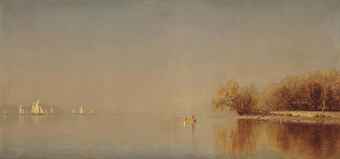

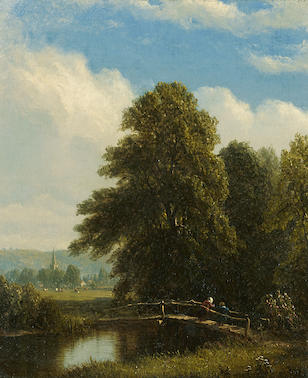

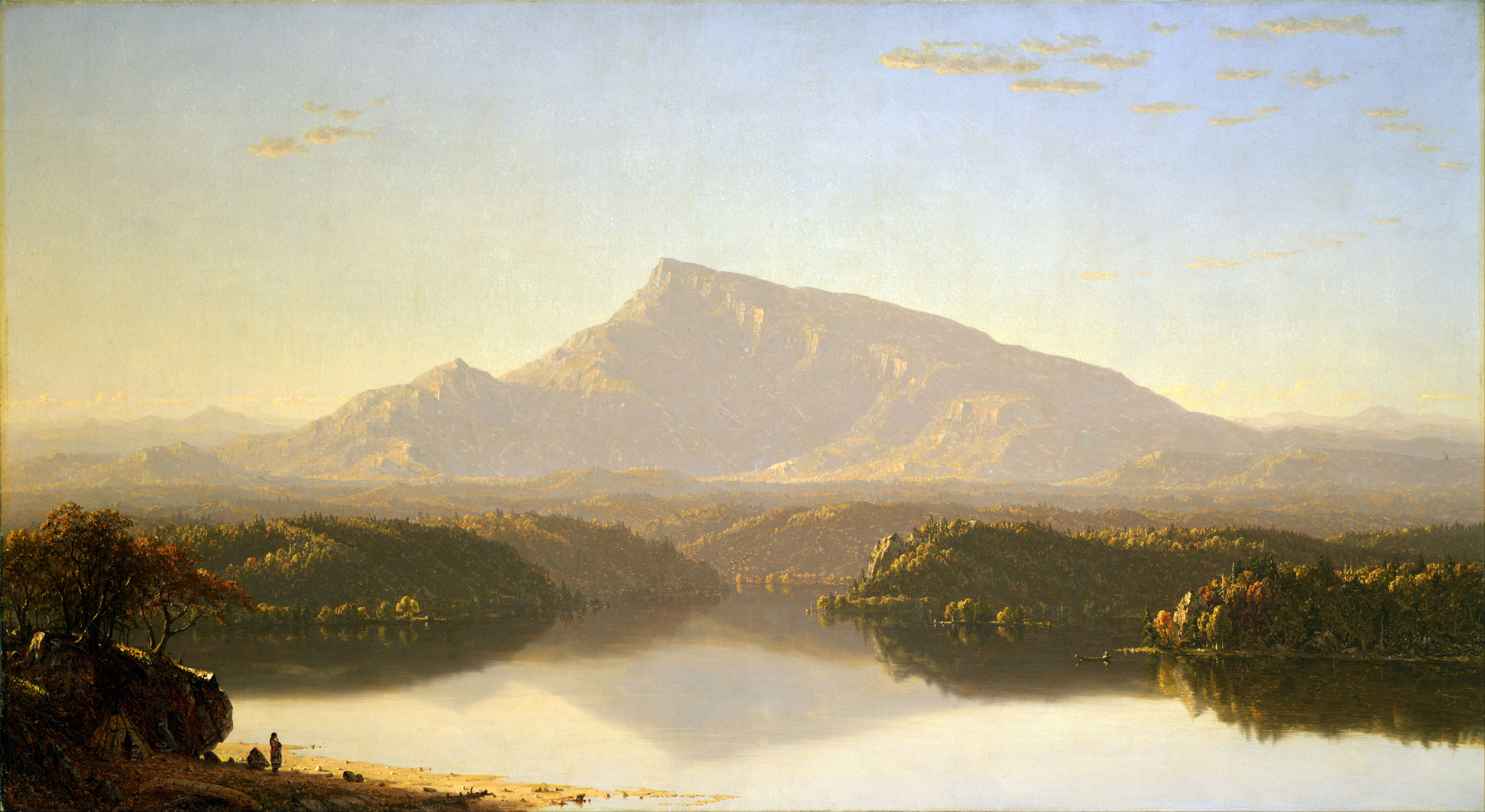
.jpg)
.jpg)
